The Angled Pocket Cycle
Introduction
This topic will explain the Angled Pocket measure cycle, will describe how to access it, will explain the options found in it, and will explain how to use it with quick steps.
The Angled Pocket Cycle

This cycle measures the distance between two planar surface faces which are parallel with each other, but not to the X Axis, nor the Y Axis. This cycle can utilize the following geometry inputs:
- Two parallel lines which are not parallel to the X or Y Axes.
- Two parallel planar surface edges which are not parallel to the X or Y Axes.
- Two parallel planar surfaces whose normals are not parallel to the X or Y Axes.
Note: The probe can be made to lift between measurements to avoid obstacles. The touch points move away from each other as it is meant to measure pockets.
Navigation
To access the Angled Pocket cycle:
- In the CAM Tree, locate the desired Machine Setup for the Probing cycle, right-click the Machine Setup, and select Probing.
The Probing dialog launches in the Data Entry Manager. - Click the Operations(s) tab.
- Click the Parameters tab.
By default the Selected Geometry list is given focus to allow you to select geometry from the graphics area. - Select the applicable geometry.
The geometry is added to the Selected Geometry list and the Initial Position and Parameters section are populated.
Note: Some geometry may be applicable to several cycles. In these cases the cycle that is selected based on the geometry may not be the intended cycle. In these cases, simple choose the correct cycle from the drop down list.
The Data Entry Parameters
Initial Position
-
X - determines the start point for the cycle along the X-axis of the current Work Offset.
-
Y - determines the start point for the cycle along the Y-axis of the current Work Offset.
-
Z - determines the start point for the cycle along the Z-axis of the current Work Offset.
Parameters
-
Z Measure Height - determines the end point for the cycle along the Z-axis of the current Work Offset.
- Angle - determines the angle at which the probe will travel to make contact.
-
Pocket Width - determines the width between surface contact points.
-
Update Work Offset
 - Updates the existing work offset values with the information received from the cycle.
- Updates the existing work offset values with the information received from the cycle. - Does not update the existing work offset.
- Does not update the existing work offset.
Options
-
Radial Clearance - determines how close to the contact surfaces the probe should travel prior to moving down in the Z Axis.
 - With this check box selected, the value entered will determine how far away from the selected surface the probe will travel before moving down to make contact.
- With this check box selected, the value entered will determine how far away from the selected surface the probe will travel before moving down to make contact. - With this check box cleared, no extra clearance will be added.
- With this check box cleared, no extra clearance will be added.
Quick Steps - Angled Pocket
- In the CAM Tree, locate the desired Machine Setup for the Probing cycle, right-click the Machine Setup, and select Probing.
The Probing dialog launches in the Data Entry Manager. - Update the Material Approach and Feature Parameters as necessary.
- Click the Operations(s) tab.
- On the Probe page, select, or define, the Probe to be used.
- Click the Parameters tab.
By default the Selected Geometry list is given focus to allow you to select geometry from the graphics area. - Select the desired piece(s) of geometry.
The geometry is added to the Selected Geometry list and the Initial Position and Parameters section are populated.
Important: The available cycles are filtered by the geometry selected. If you selected geometry and do not have the desired cycle available, remove the geometry and reselect geometry compatible with the cycle.
- Update the Initial Position and Parameters sections as needed.
- Click the Options tab and update any options necessary.
- Click OK.
Example 1 - Angled Pocket
In this example we:
- Select the Probe feature.
- Select a probe for the cycle.
- Update the Machining Data and Feed groups.
- Select the cycle.
- Updating the cycle.
- Adjust the Initial Position.
- Update the Parameters section.
- Utilize the Options page.
- Backplot the result.
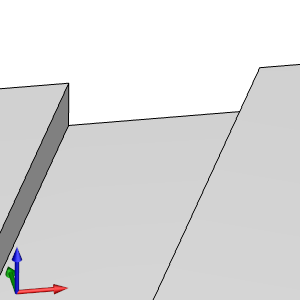

Part 1) Selecting the Probe feature
The first step of any Probing cycle is to create a Probing feature in the Machine Setup it is intended to be used in.
- In the CAM Tree, locate the desired Machine Setup for the Probing cycle, right-click the Machine Setup, and select Probing.
The Probing dialog launches in the Data Entry Manager.
Part 2) Selecting the Probe
Selecting a probe can be done with the following steps, or by simply deselecting the System Tool check box and inputting the appropriate data into the required fields.
- By default Measure is already in the Current Operations list. This will give us access to all available measure cycles in the Operation(s) tab.
At the top of the dialog, click the Operation(s) tab. - By default the Probe page is active. In this page, click the Tool Crib button.
The Tool Crib dialog launches. - Select your probe from the Tool Crib.
- If a probe has not yet been added to your Tool Crib, select the Add From Tool Library button and select one.
- If a probe has not yet been added to your Tool Library, select the
 Add button, define the probe in the Tool Parameters section, and select OK.
Add button, define the probe in the Tool Parameters section, and select OK.
The probe is added to the Tool Library and is automatically highlighted. - Click OK.
The probe is updated in the dialog.
- If a probe has not yet been added to your Tool Crib, select the Add From Tool Library button and select one.
Part 3) Updating the Machining Data and Feed groups
When selecting a tool from the Tool Crib, a tool number, and the Height and Diameter Offsets should already be correct. However, if you need to update them, you can do that in the Machining Data group. The Feed group will allow you to set a Protected Feedrate for the probe.
- Update the Machining Data as needed:
- Update the Tool Number if needed.
- To have the cycle update the Height and Diameter Offset, select the Override Offset button and enter the values to update the offsets to.
- Update the Tool Number if needed.
- Update the Protected Feedrate in the Feed group as needed.
Part 4) Selecting the Cycle
The cycle can be selected with the drop down list under the Cycles section, but simply selecting the appropriate geometry will usually select the required cycle automatically. Since certain geometry could be applicable to several cycles, in some cases, the list will become much smaller.
- Click the Parameters tab.
By default the Selected Geometry list is given focus to allow you to select geometry from the graphics area. - Select the edge of one of the planar surfaces whose normal is not parallel with the X or Y Axes.
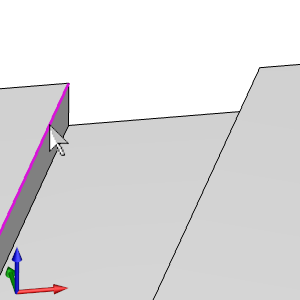
The geometry is added to the Selected Geometry list, the Initial Position and Parameters section are populated, and the toolpath becomes visible.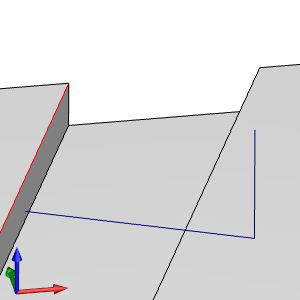
Since our current geometry works for a Angled Surface in XY Plane cycle, that is the cycle that is currently selected for us. - Select the edge of the parallel surface.
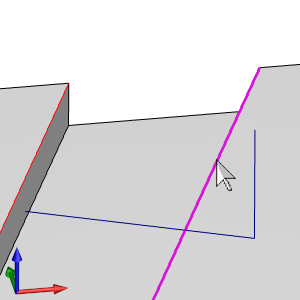
The geometry is added to the Selected Geometry list, the and the Initial Position and Parameters section are populated, and the toolpath becomes visible.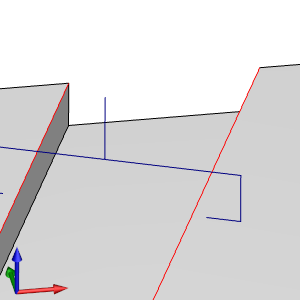
Part 5) Updating the cycle
In this case, the geometry we have chosen could be interpreted as a Angled Web cycle. Had we chosen the planar surfaces themselves instead of the edges, the proper cycle would be selected already.However, since we did not, we will need to update the currently selected cycle.
- At the top of the Cycles section click the drop down list and select Pocket from the list.
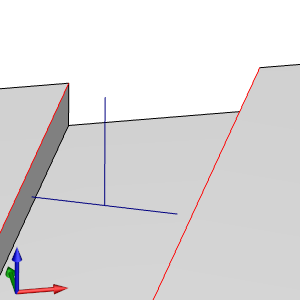
The toolpath and the available Parameters update.
Part 6) Adjusting the Initial Position
There is quite a bit of logic that goes into creating the initial position for you based on the geometry, and the cycle that you choose. While the initial position does not need to be adjusted in this case, we will play with a few of the values to explore how the toolpath reacts.
- In the Initial Position group, update the X value by adding +0.25 to the end, and pressing Tab.
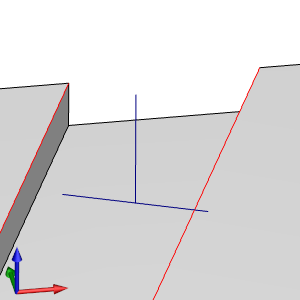
The value and the toolpath update to put the initial position of the probe a half inch further forward in X.
However, notice how the end positions are tied to the initial position. Since this is obviously not what we need, we will set that value back as it was. - In the Initial Position group, update the X value by adding -0.25 to the end, and pressing Tab.

The value and the toolpath update to put the initial position back in its original position.
Part 7) Updating the Parameters section
The Parameters section for this cycle consists of the Z Measurement Height, the Pocket Width and the Update Work Offset value. In this case we only want to adjust the height at which the probe will make contact. The Pocket Width is automatic and should not need to be adjusted, and the Update Work Offset value can be used as needed.
- In the Parameters section, update the Z Measurement Height value by adding -0.25 to the value and pressing tab.

The toolpath is Z value is updated, and in a side view we can see the toolpath has updated to reflect the height at which the probe will make contact.
Part 8) Utilizing the Options page
The values in the Options page should only be utilized if you are familiar with exactly how the individual options work.
- Click the Options tab.
- Update any and all options that are needed for the cycle.
- Click OK to exit the dialog.

The dialog closes and the Probing feature is added to the CAM Tree.
Part 9) Backploting the result
The Backplot is a great way to verify the movements of any of the operations you create.
- In the CAM Tree, right-click the C Measure operation in the Probing feature and click Backplot.
The Backplot dialog launches, and the probe and first move become visible.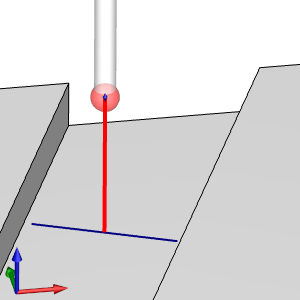
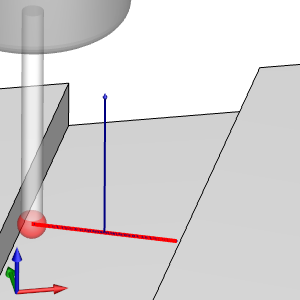
- Click Next twice to view the probe movements.
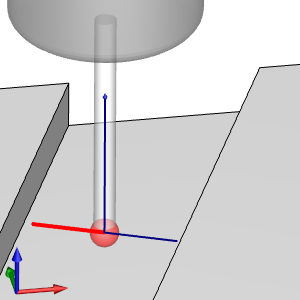

- Click Close.
The dialog is closed and the feature is ready to post.
Example 2 - Angled Pocket with Web
In this example we:
- Select the Probe feature.
- Select a probe for the cycle.
- Update the Machining Data and Feed groups.
- Select the cycle.
- Update the cycle.
- Update the Options section.
- Adjust the Initial Position.
- Utilize the Options page.
- Backplot the result.
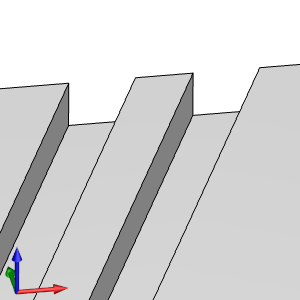
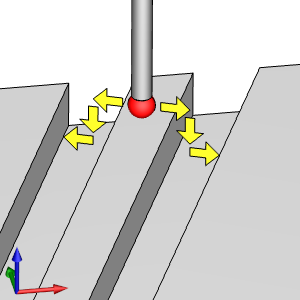
Part 1) Selecting the Probe feature
The first step of any Probing cycle is to create a Probing feature in the Machine Setup it is intended to be used in.
- In the CAM Tree, locate the desired Machine Setup for the Probing cycle, right-click the Machine Setup, and select Probing.
The Probing dialog launches in the Data Entry Manager.
Part 2) Selecting the Probe
Selecting a probe can be done with the following steps, or by simply deselecting the System Tool check box and inputting the appropriate data into the required fields.
- By default Measure is already in the Current Operations list. This will give us access to all available measure cycles in the Operation(s) tab.
At the top of the dialog, click the Operation(s) tab. - By default the Probe page is active. In this page, click the Tool Crib button.
The Tool Crib dialog launches. - Select your probe from the Tool Crib.
- If a probe has not yet been added to your Tool Crib, select the Add From Tool Library button and select one.
- If a probe has not yet been added to your Tool Library, select the
 Add button, define the probe in the Tool Parameters section, and select OK.
Add button, define the probe in the Tool Parameters section, and select OK.
The probe is added to the Tool Library and is automatically highlighted. - Click OK.
The probe is updated in the dialog.
- If a probe has not yet been added to your Tool Crib, select the Add From Tool Library button and select one.
Part 3) Updating the Machining Data and Feed groups
When selecting a tool from the Tool Crib, a tool number, and the Height and Diameter Offsets should already be correct. However, if you need to update them, you can do that in the Machining Data group. The Feed group will allow you to set a Protected Feedrate for the probe.
- Update the Machining Data as needed:
- Update the Tool Number if needed.
- To have the cycle update the Height and Diameter Offset, select the Override Offset button and enter the values to update the offsets to.
- Update the Tool Number if needed.
- Update the Protected Feedrate in the Feed group as needed.
Part 4) Selecting the Cycle
The cycle can be selected with the drop down list under the Cycles section, but simply selecting the appropriate geometry will usually select the required cycle automatically. Since certain geometry could be applicable to several cycles, in some cases, the list will become much smaller.
Note: The Pocket measure cycle measures the distance between two parallel surfaces that are both either parallel with the Y Axis, or the X Axis. In this case we measure two surfaces parallel with the Y Axis.
- Click the Parameters tab.
By default the Selected Geometry list is given focus to allow you to select geometry from the graphics area. - Select the edge of one of the planar surfaces whose normal is not parallel with the X or Y Axes.
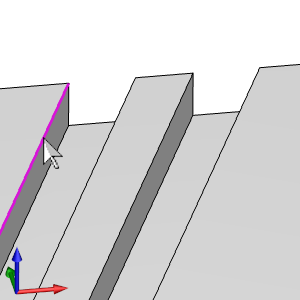
The geometry is added to the Selected Geometry list, the Initial Position and Parameters section are populated, and the toolpath becomes visible.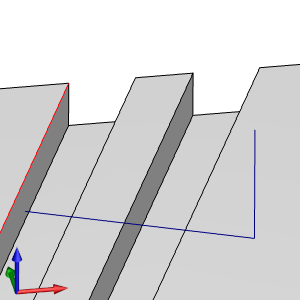
Since our current geometry works for a Angled Surface in XY Plane cycle, that is the cycle that is currently selected for us. - Select the edge of the parallel surface.
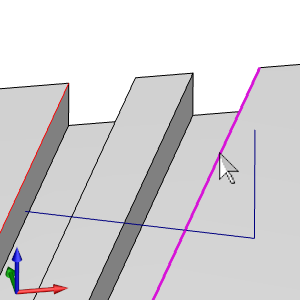
The geometry is added to the Selected Geometry list, the and the Initial Position and Parameters section are populated, and the toolpath becomes visible.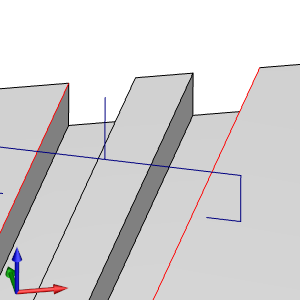
Part 5) Updating the cycle
In this case, the geometry we have chosen could be interpreted as a Web cycle. Had we chosen the planar surfaces themselves instead of the edges, the proper cycle would be selected already.However, since we did not, we will need to update the currently selected cycle.
- At the top of the Cycles section click the drop down list and select Pocket from the list.
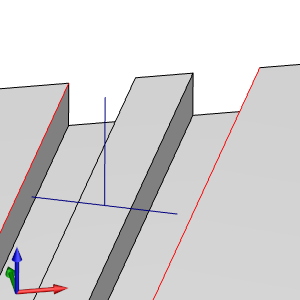
The toolpath and the available Parameters update.
Part 6) Adjusting the Initial Position
There is quite a bit of logic that goes into creating the initial position for you based on the geometry, and the cycle that you choose. While the initial position does not need to be adjusted in this case, we will play with a few of the values to explore how the toolpath reacts.
- In the Initial Position group, update the X value by adding +0.25 to the end, and pressing Tab.

The value and the toolpath update to put the initial position of the probe a half inch further forward in X.
However, notice how the end positions are tied to the initial position.Since this is obviously not what we need, we will set that value back as it was. - In the Initial Position group, update the X value by adding -0.25 to the end, and pressing Tab.

The value and the toolpath update to put the initial position back in its original position.
Part 7) Updating the Parameters section
In this case the only parameter we will be updating is the height at which the probe makes contact. We will adjust it so that we make contact one eighth of an inch below the top edge of the pocket.
- In the Parameters section, update the Z value by adding -0.25 to the value and pressing tab.


The toolpath is Z value is updated, and we can see the toolpath has updated to reflect the height at which the probe will make contact.
Part 8) Updating the Options section
The Options section for this cycle consists of the Radial Clearance value only.Selecting this check box will update the moves to first avoid an obstacle before dropping down. The value will allow you to set how close to the surfaces to move before dropping down to the contact depth.
Note: The next several steps will be shown in a cut-away side view so we can get a better feel for what is happening.
- In the Options section, select the Radial Clearance check box.


The toolpath is updated to avoid an obstacle before dropping down.
Part 9) Utilizing the Options page
The values in the Options page should only be utilized if you are familiar with exactly how the individual options work.
- Click the Options tab.
- Update any and all options that are needed for the cycle.
- Click OK to exit the dialog.
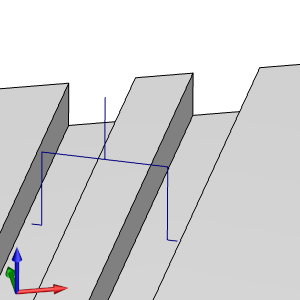
The dialog closes and the Probing feature is added to the CAM Tree.
Part 10) Backploting the result
The Backplot is a great way to verify the movements of any of the operations you create.
- In the CAM Tree, right-click the C Measure operation in the Probing feature and click Backplot.
The Backplot dialog launches, and the probe and first move become visible.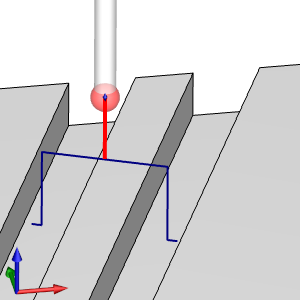
- Click Next twice to view the probe movements.
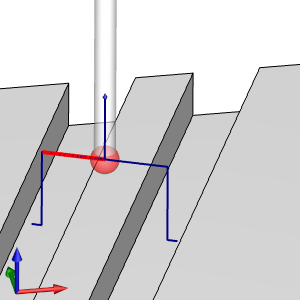

- In this case it looks like the radial clearance we used it fine to clear the obstacle. Click Next two more times to ensure the probe is clear.

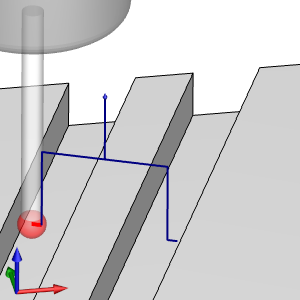
- Click Close.
The dialog is closed and the feature is ready to post.






